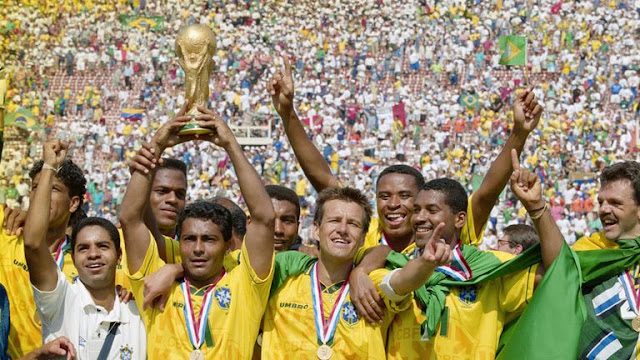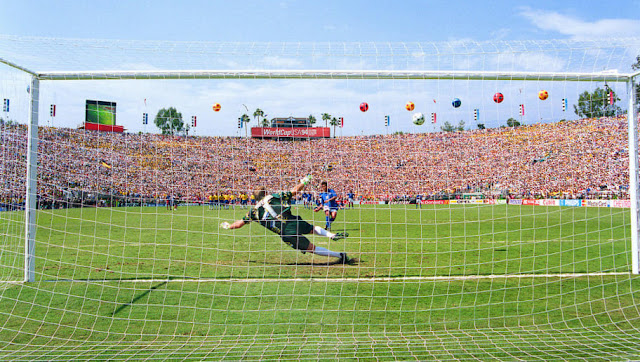42 BRAUSA Quiniou
A Hollywood script for the nation that does primetime like no other - the United States, in their own World Cup, against Brazil on July fourth no less. We had an anti-hero too (not the French referee Joël Quiniou who refereed the game very well) but Leonardo, whose brutal elbow on Tab Ramos was so violent that it put the US player in hospital for nearly a month.
Leonardo was shown the red card by Quiniou, and despite playing the whole second half a man up, Brazil deservedly eliminated the hosts by a goal to nothing, reaching the quarterfinal. The Americans participation in their own tournament, despite huge European skepticism before a ball kicked, had been a success.
What an occasion then for the officials to be part of, led by the Frenchman Quiniou, who had left a very good impression in his two group stage games (SWERUS - GERKOR). With his characteristic unobtrusive and elegant style, he showed to be one of the best weapons in FIFA's arsenal for the third time running - even if the second yellow card had to be a straight red.
Let's start by looking at those two red cards, the first much more notable than the second.
Key Match Incidents
43' - Red Card to Brazil no.16 (Violent Conduct)
Irritated by a determined holding foul on him by Tab Ramos, Leonardo struck his opponent with an extreme amount of force, so much so that Ramos was hospitalised (how the US player is the immediacy of the incident is quite disturbing).
The referee was quickly there, red card out, and between him and the Swedish linesman Mikael Everstig they prevented the United States players from getting any retribution on Leonardo for his brutal act.
Ramos was cautioned, correctly so, for his holding offence though in somewhat uncomfortable circumstances.
86' - Second Yellow Card to United States no.21 (SPA)
Already cautioned, Fernando Clavijo was correctly dismissed for his foul on Romário. While Quiniou issued only a booking for that incident, Clavijo should have been shown a straight red card - Romário was very clearly in on goal (crucial mistake).
Given it was pretty obvious who was going through at that point especially, not the most relevant mistake of the finals, but a formally incorrect nonetheless.
Balance
The rest was very good from Quiniou - though he ignored a clear yellow card at 37' (- 0,1). He could be very confident of a further match, and there is no reason why he couldn't have gotten the final itself.
Both linesman belonged to the stronger performers thus far. Park Hae-yong faced a really challenging first half and performed very well but for an important mistake in a cross-over situation at 32' (- 0,3). Of course sh*t happens, but one shouldn't give offside from a throw-in regardless as he did at 79' (- 0,1); Quiniou correctly waved the Korean linesman's flag down.
Mikael Everstig was quieter, but incorrectly disallowed a Brazil goal at nil-all in the second half - crossing over, Romário was clearly onside when the ball was kicked (crucial mistake). Sweden's progress ensured that this would anyway be Everstig's (and quite rightly fourth official Bo Karlsson's) last active participation in the competition.



A few thoughts, as I have strong memories of this game from my youth.
ReplyDelete1) I felt both the Dunga and Stewart fouls highlighted in your video were mandatory YCs. I understand having some leeway, but those were both reckless and SPA.
2) What do you think he called against Bebeto when Bebeto went down easily? No misconduct, yet he stopped play for a foul...
3) I have ALWAYS wondered about the Ramos YC. Both its veracity and its delivery. For delivery, the idea of "using the captain" reached some mythical circles in American refereeing after this. Outside this incident, have you ever seen that done? As far as its veracity... it's true there was blatant holding but when you weigh the consequences of a potential SPA up against the fact that the player had a broken skull and it was NOT a 2YC... do you really need to give it? I feel like you could explain the foul was against Ramos so Brazil gets the free kick and be done with it. Not sure the YC was necessary given the overall circumstances.
4) You're right in today's game Clavijo's 2YC should be a direct red card. You are also correct that, by the absolute letter of the law it should have been a direct red card then. I still don't think it was an expected red card yet. You've got to remember we are only one year after Koeman's famous non red-card in the England qualifier. Despite the updated laws, referees still weren't punishing what we now call DOGSO as liberally as the modern game does. This was from a wide position, was not a very physical foul, and was relatively far from goal. I don't think there was a referee at the tournament with the possible exception of Brizio Carter who would have given this as a direct red. Doesn't make it right, but I think it's important context.
Regarding 3): I have seen this by Buquet in a qualifier between Bulgaria and Montenegro where a MNE player got injured during a tackle and was stretchered off. Buquet then called the MNE captain over and showed the YC with the direction towards the sidelines where the stretcher was.
DeleteI agree also regarding the card itself. It was for me neither a clear enough attack to warrant a SPA caution, nor was it blatant (and long/intense) enough for LoR. Could have been avoided.
Thanks for your detailed comment!
Delete1)
Agree, both should be simply be cautions - would support as observer (ie. no - 0,1) in Stewart's case, not Dunga's though which was simply too clear.
2)
Quiniou (surely) did the same thing there as he did in his first game [SWERUS, start of the 2H], he awarded an indirect freekick for simulation but not a caution. If I remember correctly, the mandatory YC for a simulation call only became obligatory as late as 1999. José Roberto Wright also awarded an indirect freekick for simulation but did not caution the perpetrator in the Italy - Austria game at WC 1990.
We can 'look forward' to a caution for simulation in the next game of this tournament :) which is the first in all the games unless I'm forgetting sth.
3)
Yeah I think you are right, a freekick to Brazil was enough here really. It was quite unsettling seeing Ramos booked to be honest; I don't think that sanction really had any tactical value either.
Maxi beat me to the MNEBUL incident! :D
4:50 of this HL video
https://streamable.com/sxt29
4)
By chance actually I was watching a roundup of the last round of matches in the UEFA zone on the road to WC 1994 the other day - here are two very interesting DOGSO calls, by Vasílis Nikákis and Hellmut Krug respectively (both 'pre-selected' for WC 1994 at that point).
https://youtu.be/Fbv9Zq4kq8g?t=12802
https://youtu.be/Fbv9Zq4kq8g?t=13033
Krug's also looks a clear SFP, but - a more vague notion of 'last man' seemed to be the guiding principle. Ironically, it seems we are heading back to the early, less 'cold', definition of DOGSO nowadays.
The most interesting thing to consider for me re. the Clavijo dismissal is whether he would have walked if not having been cautioned. I'm really not sure either way!
Also your comment leads onto considering if assessing KMIs / giving marks for games over a quarter of a century ago is a bit obsolete, but I hope my analysis remains relevant nonetheless!
This bit I found especially fascinating - "For delivery, the idea of "using the captain" reached some mythical circles in American refereeing after this". It's amazing how one game can have such a big effect in perceptions / views amongst a group of people!
The thought just occurred to me - do you think Buquet replicated the management of his compatriot in MNEBUL not as an accident (he surely would have watched this game on television)? :)
DeleteThanks for the replies.
DeleteYes, it is interesting how individual situations can have those effects! For me (and I think you both see to agree) the severity of Ramos' injury and the tournament setting is what makes the YC unnecessary. In the BUL-MNE situation, maybe the tackling player returns. Or maybe a YC would hurt for accumulation. But it was pretty clear in this situation that Ramos was not going to play again at the World Cup. When you couple that with the doubtful nature of the YC to begin with, I just think it could be avoided. It wasn't necessary to placate the Brazilian team, which in my opinion is the only argument in favor of it.
I remember the Spain DOGSO card. I think what makes that so clear is it is the goalkeeper with no defender behind him. If that same tackle, with the same direction "toward goal" was made by a defender... I'm not sure what the answer would have been in 1993.
For the Belgium red card, I tend to believe it was for the SFP, too!
An interesting historical quirk, but as I'm sure you know or learned recently... both of those red cards had the potential to knock the home teams out of the World Cup. Spain and Belgium both held onto results despite going down a man, but if either team had lost that day they'd have been out of the World Cup. It makes both decisions all the more courageous given the consequences and the era.
Regardless of what those two clowns on the English track rambled about, I thought this was an EXCELLENT performance by Quiniou. If there is something to criticize, it would be a missing caution for Dunga for his reckless SPA foul (Stewart in 2nd half maybe as well) in the first half and maybe a stronger line against Brazil's players constantly demanding YCs.
ReplyDeleteApart from that: Fully correct RC (the YC for Ramos is harsh and in this case I'd argue needless, going up to his stretcher and pulling down the shorts to get the number might appear rather cold). But it encapsules what Quiniou was: A referee out there doing his job, not caring overly much about what was expected. If the commentary is good for anything, it is to prove how brave these fully correct decisions were.
The SYC instead of RC is a a technicality in my eyes (in 1994) and rightfully did not hinder any further appointment of Quiniou.